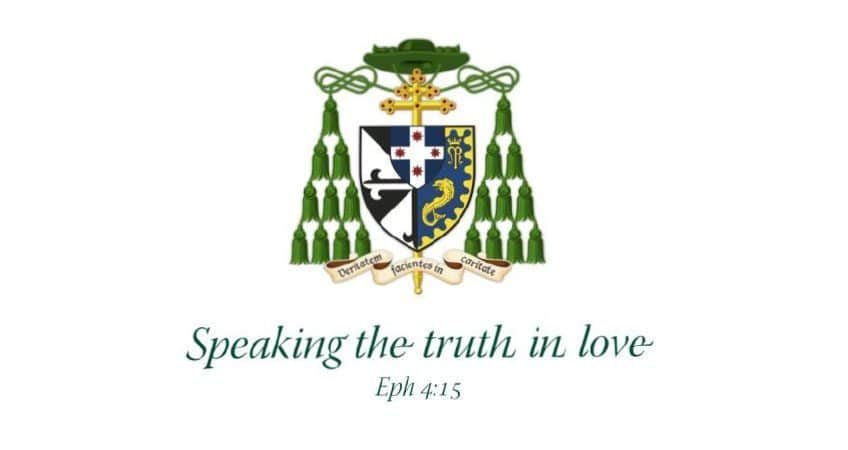HOMILY FOR MASS OF THE 17TH SUNDAY OF ORDINARY TIME YEAR B

Livestreamed from St. Mary’s Basilica, Sydney, 25 July 2021
There are 37 miracles recorded in the Gospels, most of them in Matthew, Mark and Luke. John’s Gospel, which we heard today, is different. John only reports eight miracles, six of them uniquely among the evangelists, and all of them at much greater length.
Why’s that? Well, at the very end of his Gospel John says, “If all the things Jesus did were written down, I suppose the world itself could not contain all the books it would require!” (Jn 21:24-5) So he was selective, as every writer is. But unlike many, he was clear about the basis of his choice: “I’ve picked these signs,” he says, “so that you may come to believe that Jesus is the Messiah, the Son of God, and have life through believing in his name.” (Jn 20:30)
Sure enough, there’s a pattern to the miracle stories John chose for us. For one thing, each addresses a particular human need. Newlyweds face humiliation after running out of wine at their reception (2:1-11). A father is anxious about his little boy dying of fever in a distant town (4:43-54). A paralytic has long tried to scramble into a miracle pool to no avail (5:1-9) . Men at sea in a storm are terrified of drowning (6:16-21). There’s a guy who is physically and spiritually blind (9:1-12). A man has died and the family are grief-stricken (11:4-11). Others have fished all night and caught nothing (21:4-11). In a few stories John illustrates how Jesus addresses the whole range of human needs – physical, emotional, intellectual, social and spiritual – for He cares about every aspect of human fulfilment.
Some have noticed that John’s miracle stories come in threes, as if to underline three times what they tell us about Christ. Three miracles of healing demonstrate He is ‘the Physician of Bodies and Souls’ (6:2; cf. Mk 2:17 et par). Three of feeding, that He is ‘the Bread of Life’ (6:35; cf. 4:13-14). In three darkness is replaced by faith, for Jesus is ‘the Light of the World’(8:12; 9:5, 39). Three more demonstrate that He is ‘the Way, the Truth, and the Life’ (14:6). And three tackle life and death, as Jesus is ‘the Resurrection and the Life’ (11:25).
Another way of reading these miracle stories is in terms of the virtues of faith, hope and love. In some people’s faith elicits Jesus’ miraculous response: Mary has faith that her Boy can fix the hospitality catastrophe at Cana (2:3), the official believes He can heal his dying boy even from a distance (4:50), and Martha confesses Jesus “the Messiah, the Son of God, come into the world” even before He raises her brother (11:27; cf. v. 32). In other stories it’s Jesus’ miracles elicit people’s faith: with respect to Lazarus He is clear that’s precisely what it’s about (11:15, 40, 42, 45); so, too, a paralytic and a blind man both testify that Jesus is their healer sent by God (5:11,15; 9:11, 17, 32-33, 38); a haul of fish leads the men to exclaim “It is the Lord!” (21:7); and when He heals the official’s boy, John records, “the man himself believed, along with all his household.” (4:53) Faith, then, is at the heart of all Jesus’ signs: the faith to seek and recognise a miracle; or the gift of faith received through witnessing Jesus’ power and in turn giving witness to it; and the faith the retelling of this story is intended to stir up in us.
There’s plenty of hope and love in these stories too which I won’t tease out today. It’s enough to note that everyone recognised Jesus’ love for Lazarus (11:3, 35-36) and that after the haul of fish Peter professes his love for Jesus three times (21:7, 15-17).
Which brings me to the Miracle of the Loaves and Fishes (6:1-15). Following John’s pattern it begins with human need: the crowd are hungry, and Jesus delivers food in abundance. But their deepest hunger was spiritual, as John indicates by mentioning the Passover and people’s searching (6:2,4). Jesus addresses their emotional need by gathering them, their intellectual need by teaching them, their physical need by feeding them, their spiritual need by sanctifying them. As He sates them with food, He demonstrates that He is ‘the Bread of Life’ and ‘True Food’ in answer to their spiritual hunger (6:35, 50-51).
We respond with faith, hope and love. The people’s faith is real, if somewhat misguided: they follow Jesus because they believe in the signs He has worked and are hoping for more (6:2, 26, 29); seeing His new sign, they proclaim Him a prophet (6:14-15). And there is devotional love also, as they decide to make Him their king (6:15).
Yet some elements of today’s story mark it out as different to Jesus’ other signs. For one thing, it’s bigger. Most of the other miracle stories are rather intimate encounters between Jesus and a single person, or a family, or His little circle of friends. The wedding reception at Cana was bigger, but even country weddings don’t have 5,000 guests. For a ‘multitude’ to witness a miracle is really something. It made such an impression that, uniquely of all Jesus’ miracles, it’s recorded in all the Gospels (Mt 14:1-12 cf. 15:32-9; Mk 6:31-44 cf. 8:1-9; Lk 9:12-17; Jn 6:1-14). Clearly we should sit up and pay attention…
Another unique aspect of this story is that Jesus worked it with the active participation of the apostles. While Jesus took the bread, blessed and thanked, and even helped distribute, He directed the apostles reverently to gather up the fragments into twelve baskets (6:12-13). And so, just as the miracle of the loaves introduces Jesus’ discourse on the Eucharist, so His associating the Twelve with this miracle introduces them as its future priests. If all Christians are called to share in Jesus’ ministry, some are ordained to particular service of the Bread of Life.
A third and final difference about this miracle is how much Jesus gave. Our word charity comes from the Latin caritas, meaning an active ‘giving’ love. Christ could have told ‘the ladies’ to bring a plate or conducted a ‘whip around’ amongst the men to fund the food. Instead He told the apostles – the Church – to find amongst themselves the wherewithal to feed the multitude – gifts He would multiply abundantly. So they gave all the bread and fish they had, holding none back for themselves. Jesus, too, gives Himself totally: He is the Bread from Heaven, His flesh given for the life of the world (6:25-58). To work His wonders in us, Jesus gives us Himself, not just figuratively, but really, totally, and always.
The COVID-19- restrictions are preventing most people from receiving the Bread of Life. Fortunately priests can still bring the sacraments to the sick and people can join the Mass through live-streaming and at least make a ‘spiritual communion’. Throughout this time of lockdown we must, in Paul’s words, “Bear with one another charitably, in complete selflessness, gentleness and patience” (Eph 4:1-6). But we hunger, hunger for that day when we can gather as a multitude once more, hunger for that day when we can sit together to hear our Eucharistic Lord, hunger for that day when we will again be fed by Him the Bread of Life.
ANNOUNCEMENT IMMEDIATELY AFTER THE AGNUS DEI
Before Genuflecting
Because current circumstances impede attendance at Mass and reception of Holy Communion, I invite those who are joining us by live-streaming to ask God that by spiritual communion you might receive the graces of sacramental communion. Offer this Mass and your hunger for the Eucharist for the safety of your loved ones, of yourselves and of our world.
Welcome to St Mary’s Cathedral in Sydney for the Solemn Mass of the 17th Sunday of Ordinary Time. As the spike in cases of COVID-19 and subsequent lockdown continues to prevent us from gathering in person, I encourage you to pray: for an end to this pandemic, for those who have died of COVID and those grieving them, for the sick and those caring for them, for those testing and vaccinating us, for the isolated, lonely or anxious, for those leading us through these times, and for those places faring much worse than we are.
Last week I said that a big challenge for Christians is to find ways of maintaining their connection with God and each other during a time of enforced physical separation; the miracle of the loaves and fishes in today’s Gospel underlines the deep human need to gather and share lest we suffer spiritual separation as well. At least we can join together by live-streaming and so I welcome all those doing so this morning.

